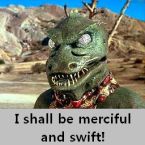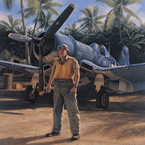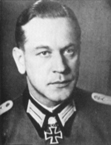Korvar
Posts: 813
Joined: 9/3/2014
Status: offline

|
quote:
ORIGINAL: geofflambert
The Wiki says that "torpedo racks were available" for the PBY but doesn't say they were ever used or if air crews were trained to attack with them.
Not only did PBYs use them, the US Navy's first torpedo night attack was on the IJN Main Body at Midway by a PBY:
quote:
Excerpt from the book Black Cats and Dumbos - WWII's Fighting PBYs by Mel Crocker
Ensign Jack Reid: Shadow The Transport Group
For the next two hours Ensign Reid shadowed the Transport Group,
flashing bits and pieces of messages as he dashed from one cloud to an
other, frantically avoiding Japanese attempts to blast his PBY out of the
sky.
On Midway, Captain Simard, confused by the incomplete messages
radioed by Ensign Reid and three other PBYs flying the southwest sectors,
dispatched Colonel Sweeney with nine B-17s to make the first of several
high-level bombing attacks on the enemy transports and strike group — all
without confirmation of more than a few near-misses.
However, by now certain facts had become clear: The “Main Body”
had only transports and oilers and their escorts, no carriers. The strike-
force— that group most concerning the men of Midway — had not been
spotted. Somewhere north of the transport group spotted by Ensign Reid
and other PBYs from Midway was the true Main Body of the enemy
armada. With that force would come the carriers and the inevitable air
attack.
But over 1100 miles southeast of Midway, at Ford Island, several
hours before Lieutenant Lyle spotted the Japanese patrol boats and Ensign
Reid located the enemy transports, a plan was taking shape that would
involve the slow, lumbering PBYs in another first in U.S. Naval history.
In the early morning hours of June 3rd, three PBYs from VP24 and
one from VP51 were prepared for an 0700 flight to Midway. Ensign Allan
Rothenberg was patrol plane commander of the PBY detached from VP51;
Lieutenant (jg) Charles Hibberd, Lieutenant (jg) Douglas Davis, and Ensign
Gaylord Propst commanded the three PBYs from VP24. Not one of these
men nor any member of their crews had the slightest inkling of the hair-
raising mission unfolding for them at Midway.
Lieutenant W. L. Richards, the executive officer of VP44, one of the
PBY squadrons assigned to Midway, took command of the mission, flying
second chair to Lieutenant (jg) Hibberd. Around 2130 they began their
historic flight.
Though the weather was clear and the sea bathed in brilliant moon
light, Ensigns Propst and Rothenberg lagged somewhat behind the
leaders, Hibberd and Davis. When the transport group was sighted
around 0130, Lieutenant Richards had Lieutenant Hibberd circle the ships
and begin his attack up the moon path.
Lieutenant Hibberd bore in on the attack, dropping altitude until he
was some 50 feet off the water. The PBY slipped closer and closer to the
large ship Hibberd had picked as his target; there was no sign of enemy
awareness. Finally, at around 800 yards, he released the torpedo and
yanked the PBY up and over his target. There was a moment of anxious waiting,
then the blister watch called out an explosion and fire in the bow of
the ship.
Lieutenant Davis made an additional circle of the ships and also at
tacked up the moon path, and though he faced no return fire, his target
began rapid evasive maneuvering. Dropping down close to the water,
Lieutenant Davis waited until he was 200 yards astern of his quarry before
releasing his torpedo, flying into heavy anti-aircraft fire as he rose up and
over the ship. His plane was riddled with bullet holes but there was no
personnel injury or crippling damage.
Ensign Propst came on the scene about the time Lieutenant Davis was
clearing out and flew his PBY into a virtual hornet’s nest. Attacking in the
same manner as his predecessors, Propst hop-skipped over a screening
destroyer and released his torpedo at 800 yards, catching the full anti-air
craft barrage of the transport group. How he brought the aircraft through
with only a few shrapnel holes defied explanation.
Ensign Rothenberg arrived much too late to effect a torpedo run with
much hope of accuracy and was forced to drop in the general direction of
the enemy group before turning back toward Midway.
As spectacular and daring as the Navy’s first night-air-torpedo-attack
was, and though it caught the enemy by complete surprise, the only dam
age was to the tanker Akebono Maru from Lieutenant Hibberd’s first run.
The other dropped torpedoes simply missed. And the Akebono Maru was
patched up and back into formation without delaying the schedule of the
transports; but the Japanese hadn’t seen the last of PBY Catalinas.
_____________________________
|
 Printable Version
Printable Version
























 New Messages
New Messages No New Messages
No New Messages Hot Topic w/ New Messages
Hot Topic w/ New Messages Hot Topic w/o New Messages
Hot Topic w/o New Messages Locked w/ New Messages
Locked w/ New Messages Locked w/o New Messages
Locked w/o New Messages Post New Thread
Post New Thread